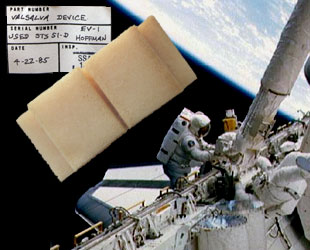
STS-51D, launched 8:59:05pm ET on April 12, 1985, was the 16th flight of the Space Shuttle and the 4th for the orbiter, Discovery. The mission marked the first flight of an elected official, Senator Jake Garn. The flight was a composite mission, carrying part of its own manifest and part of that from STS-51E, which had been canceled.
The Hughes SYNCOM IV-3 spacecraft, also called Leasat 3, was deployed on the second day of the mission in a routine operation. However, the booster stage did not fire as programmed. The orbiter returned to the vicinity and the crew examined the spacecraft.
It was determined that the 'sequence start' lever, which should have been automatically opened during the deployment sequence, was apparently not fully erected. After consultation with Hughes, Mission Control directed the astronauts in the design of two 'flyswatter' devices capable of snagging and tugging on this lever.
These were attached to the end of the Canadarm, or Remote Manipulator System, during an EVA by mission specialists S. David Griggs and Jeffrey A. Hoffman.
Each of the astronaut's helmet assemblies consisted of a transparent shell, neck ring, vent pad, purge valve, and an adjustable Valsalva device. The latter allowed Griggs and Hoffman to clear their ears as necessary by pinching their nostrils between two pieces of foam.
This Valsalva device was removed from Hoffman's helmet after STS-51D to be discarded.

© 2020 collectSPACE.com All rights reserved.
Questions? E-mail [email protected]

|